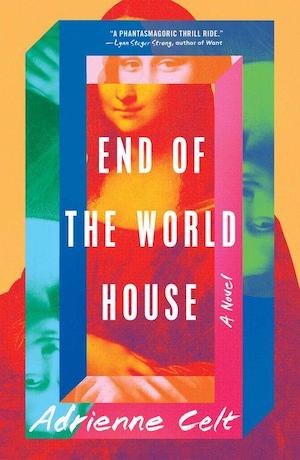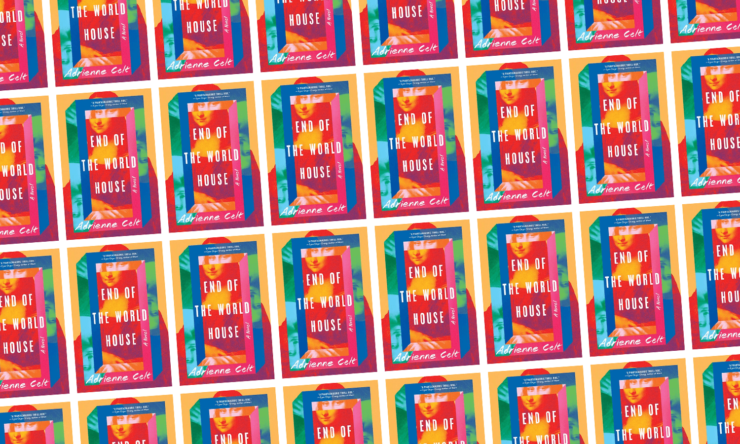It’s fair to say that if you’re working on a novel that’s suffused with the surreal, setting it in Paris is a good place to start. Much of Adrienne Celt’s End of the World House is set at the Louvre—best friends Bertie and Kate, on vacation from the Bay Area, are en route there when the book opens—and that seems like a wise decision for a work of fiction that takes a concept that’s become a full-on trope and steers it into something far more ineffable.
I don’t normally go for mild spoiler warnings, but I’m going to insert one here. Like Susanna Clarke’s Piranesi—a novel that shares a few qualities with this one—it’s a story best experienced knowing as little as possible going in. The first few chapters give Bertie, who soon emerges as the novel’s protagonist, a sense of something inherently off about the world; Celt eases the reader into this same sense of subtle wrongness before the full nature of what precisely is wrong comes into focus.
The trope in question is the time loop narrative. Bertie and Kate are at the Louvre on a day when it’s normally closed; a man they met at a bar the previous night, Javier, told them that he’d give them access to it if they showed up to a particular entrance at a certain time. They do, and they begin exploring the museum. There’s a slight tension between them—more on that in a moment—and eventually, the two become separated. And eventually, the day begins again.
Buy the Book


End of the World House
Time loops have become commonplace in science fiction and fantasy narratives, to the point that the Legends of Tomorrow episode featuring a time loop established that its characters didn’t need to explain to one another what a time loop was, it was so enmeshed in popular culture. Time loops have also been used to memorable effect in fiction—Ken Grimwood’s Replay, about a man and a woman reliving their lives over and over, made a huge impression on me at a young age.
But while “best friends navigate a substantial shift in their relationship while time keeps resetting itself” would be a fine concept all its own, Celt is going for something deeper here. For starters, this novel isn’t just set in Paris. It’s set in what seems to be a near-future world where everything frustrating about the present day—pandemics, regional wars, terror attacks, climate change-fueled disasters—have been magnified. Tonally, it’s somewhere between Martin Amis’s London Fields and Charlie Jane Anders’s All the Birds in the Sky.
This is a high-concept book, but Celt’s narration and prose help to make its more ambitious aspects click into place. She moves from omniscient narration to a relatively close third person for Bertie, which helps to fill in details on Bertie’s workplace, her friendship with Kate, her romantic history, and her own artistic frustrations. Two important things to keep in mind: when the novel opens, Bertie’s work on a graphic novel has been stifled for several years by her job as a corporate illustrator; and Kate, who’s been her best friend since their teenage years, has decided to move to Los Angeles.
In certain passages, Celt also takes the reader within Bertie’s mind to illustrate how Bertie’s perceptions of the world have shifted with her fluctuating position with respect to time. Eventually, Bertie gains more of a sense of what’s happened to her, though Celt keeps things relatively light in terms of explanations and focuses more on the sheer strangeness of it all. Luis Buñuel’s film The Exterminating Angel, about a group of characters stuck at a dinner party that they find it impossible to leave (or perhaps the underrated science fiction film Coherence, which works just as well) takes the experiential approach rather than the exposition-heavy one; like them, this novel is better for it.
Which isn’t to say that there don’t seem to be some explanations hovering just below the surface, if you’re inclined to look. Bertie’s recurring thoughts of her graphic novel, and the concept that gives this book its title, suggest a more apocalyptic undercurrent present here. Given the Bay Area setting, tech startups, virtual reality, and the Singularity all come up briefly, and some readers may want to look for analysis there. For my part, I’m content to let the surreal be the surreal, and let the handful of moments when something comes into sharp relief—sometimes terrifyingly, sometimes beatifically—make their own mark.
End of the World House is published by Simon & Schuster
 Tobias Carroll is the managing editor of Vol.1 Brooklyn. He is the author of the short story collection Transitory (Civil Coping Mechanisms) and the novel Reel (Rare Bird Books).
Tobias Carroll is the managing editor of Vol.1 Brooklyn. He is the author of the short story collection Transitory (Civil Coping Mechanisms) and the novel Reel (Rare Bird Books).










